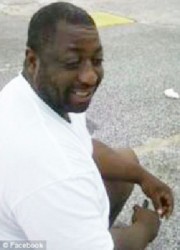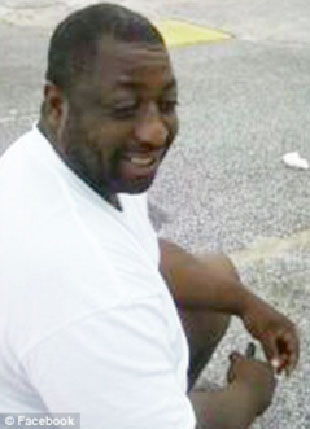NEW YORK, (Reuters) – A New York City grand jury decision not to charge a white police officer who killed an unarmed black man with a chokehold sparked outrage and protests yesterday, and the U.S. Justice Department said it would investigate the incident.
Eric Garner, a 43-year-old father of six, was illegally selling cigarettes on July 17 when police officers tackled him and put him in a chokehold. Police said he had been resisting arrest. The city’s medical examiner ruled the death a homicide.
The deadly encounter on Staten Island, New York City’s smallest borough, was captured on video, which quickly spread over the Internet and fueled debate about how U.S. police use force, particularly against minorities.
Last week, a grand jury in Missouri decided not to indict a white police officer in another racially charged killing of a black man. The decision in that case sparked a spasm of violence in Ferguson, Missouri, with businesses burned and looted.

The Justice Department is investigating whether Brown’s civil rights were violated through excessive force.
Yesterday, about two dozen demonstrators lay down in Grand Central Terminal’s main hall in Midtown Manhattan in a silent protest as the evening rush hour began. In Times Square, about 200 people gathered, chanting “No indictment is denial. We want a public trial.”
On Staten Island, near the site where Garner was apprehended, some demonstrators defiantly crushed cigarettes in front of reporters and passersby – a reference to the reason that police gave for approaching Garner in the first place.
President Barack Obama, while not directly commenting on the case, said the grand jury decision spoke to “the concern on the part of too many minority communities that law enforcement is not working with them and dealing with them in a fair way.
“We are not going to let up until we see a strengthening of trust and strengthening of accountability that exists between our communities and our law enforcement,” he said.
New York Mayor Bill de Blasio, speaking at a press conference on Staten Island, said he had spoken to U.S. Attorney General Eric Holder and the U.S. attorney for the Eastern District of New York, Loretta Lynch – whom Obama has nominated to replace Holder as attorney general.
“They made clear that the investigation initiated by the U.S. attorney would now move forward and would be done expeditiously, and would be done with a clear sense of independence and that it would be a thorough investigation,” de Blasio said.
The district attorney for Staten Island, Daniel Donovan, announced the grand jury’s decision not to indict the police officer, Daniel Pantaleo, who placed Garner in a chokehold.
“It is never my intention to harm anyone and I feel very bad about the death of Mr. Garner,” Pantaleo said in a statement released by the Patrolmen’s Benevolent Association union.
Benjamin Carr, the stepfather of Garner, said he was distraught over the verdict. “The justice system didn’t do what it was supposed to do,” he said at the site where Garner was apprehended by police and a makeshift memorial to his honor now stands.
Tempers flared at the site as about a dozen protesters expressed their anger at the grand jury’s decision.
Daniel Skelton, a black 40-year-old banker, spoke loudly as he expressed his outrage steps away from Garner’s memorial. “A black man’s life just don’t matter in this country,” he said.
POLICE PROSECUTIONS RARE
It is rare for either federal or state prosecutors to charge a U.S. police officer for excessive force, even when a death results.
The U.S. Supreme Court and lower courts have over decades ruled that police officers should have wide latitude to use violence to defend themselves and to take suspects into custody.
“There are a lot of cases where police officers don’t get indicted for what looks like extreme situations,” said Aaron Mysliwiec, president of the New York State Association of Criminal Defense Lawyers. “Many jurors and judges tend to believe police officers more than your average witness.”
In ruling Garner’s death a homicide, the city medical examiner said police officers killed him by compressing his neck and chest. His health problems, including asthma and obesity, were contributing factors, the medical examiner said.
The video of Garner’s arrest shows him arguing with police officers, saying, “Please leave me alone,” and later, “Don’t touch me,” before a group of four officers tackled him to the ground. He then began to plead with them, saying repeatedly, “I can’t breathe.” Police said later that Garner had been resisting arrest.
Donovan said he had applied for a court order to authorize the release of “specific information in connection with the Garner grand jury investigation.” The grand jury, like all in New York, had 23 members. At least 12 grand jurors must agree to bring an indictment.
De Blasio called for people to react peacefully to the grand jury decision, saying that is “only thing that has ever worked.” The grand jury decision poses the biggest challenge for the mayor since coming into office in January.
Shortly before the grand jury announcement, the New York City police launched a pilot program to equip officers with body cameras. The video camera program was ordered by a federal court judge who ruled last year that police had unfairly stopped and frisked black and Latino New Yorkers. It aims to make officers more careful and accountable about using force, de Blasio told reporters, while reducing complaints and lawsuits.

